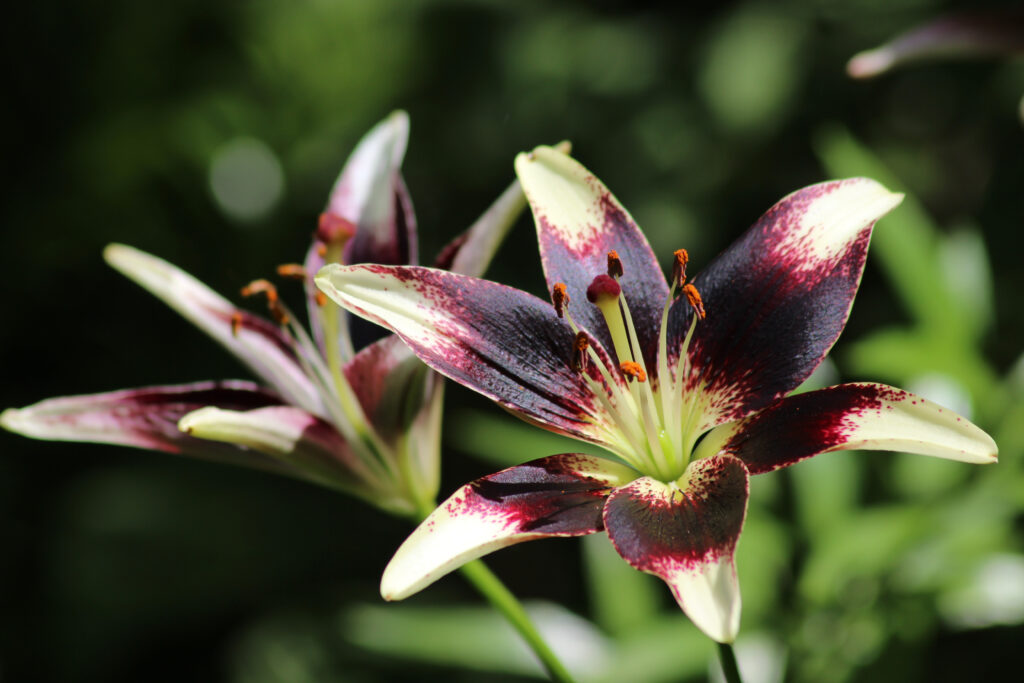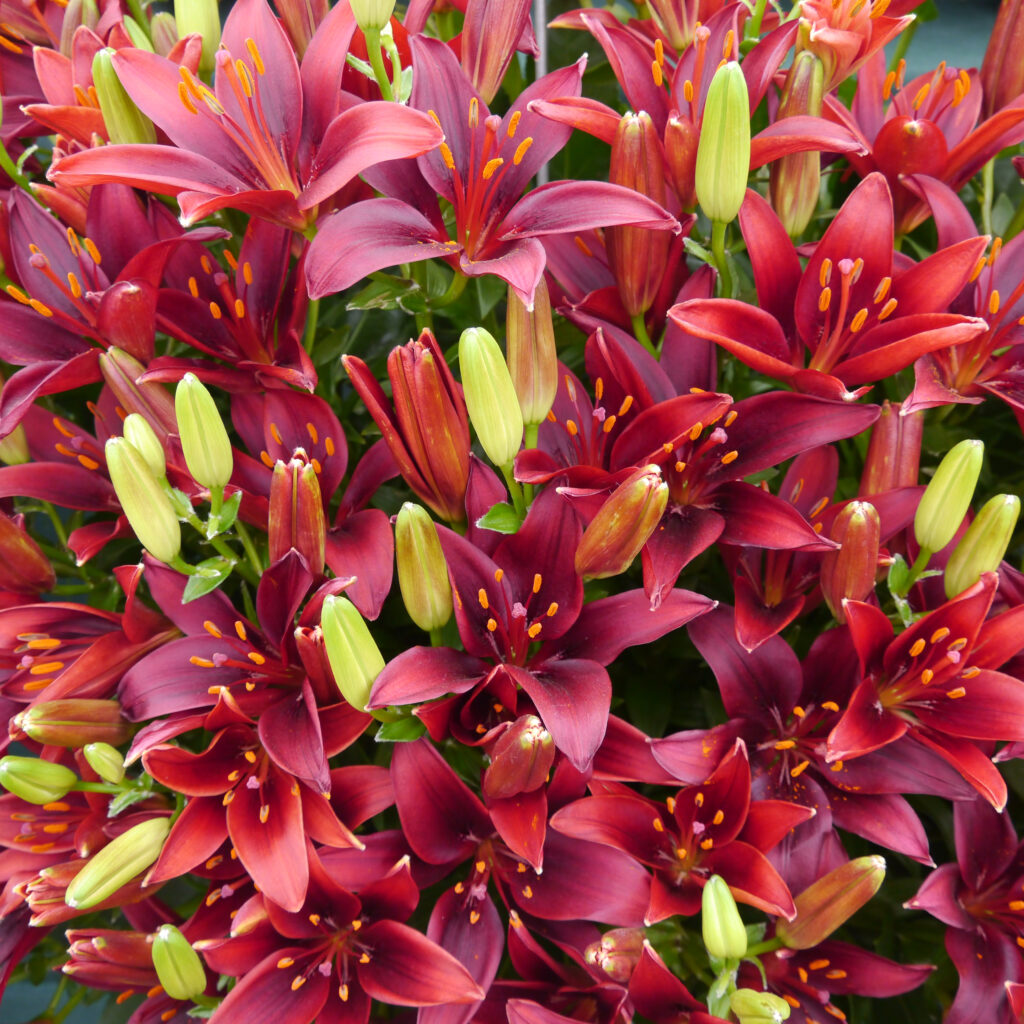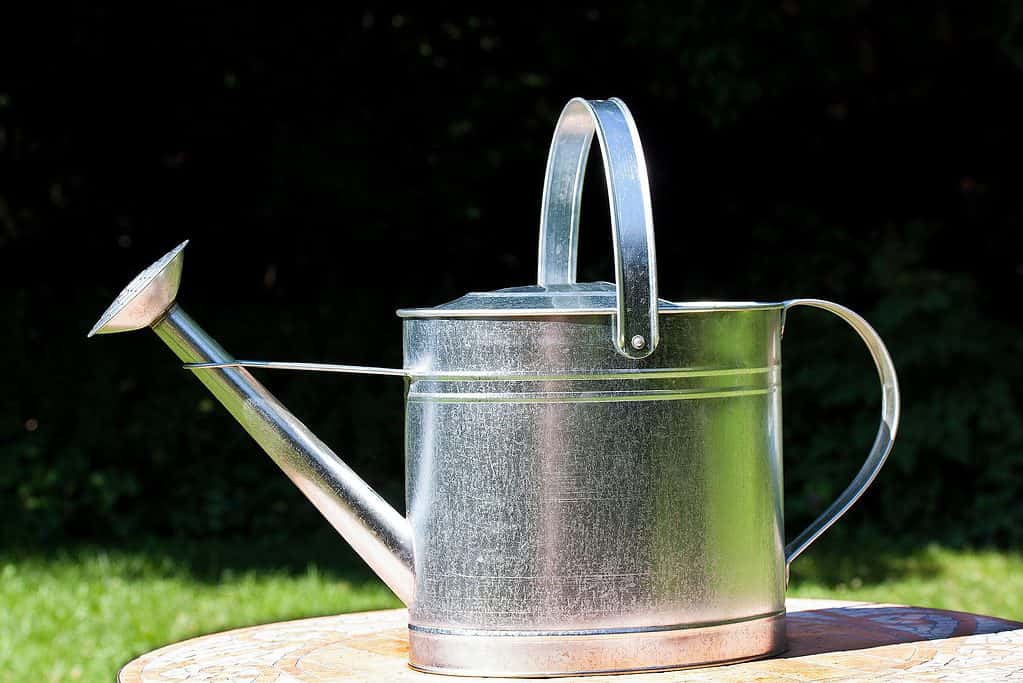
The most common types of lilies are often white, such as the famous springtime Easter lily. As lovely as white lilies are, though, they are just the beginning of what is available. Lilies can feature yellow, pink, orange, red, and even purple blooms.
Purple lilies are said to represent dignity, pride, admiration, success, and accomplishment. Purple has also been considered the color of royalty for thousands of years, so purple lilies are also seen as regal and majestic.
You, however, might just think they are beautiful flowers. And you’d be absolutely right! Let’s talk about seven types of purple lilies that can add a royal flair to your floral display. Then we’ll explore some of the basics for growing these purple beauties.
1. Purple Prince Lily (Lilium ‘Purple Prince’)
- USDA Hardiness Zones: 3-10
- Height: 6-8 feet
- Sun Exposure: Full, partial
The Purple Price is an Oriental-Trumpet hybrid lily that grows three to four feet high in the first year but can reach impressive heights of up to eight feet at maturity. While the plant is quite sturdy, it should still be staked to protect it from wind damage.
The plant can grow in a wide range of hardiness zones, from Zones 3-10. The Purple Prince lily can thrive in U.S. gardens from Minnesota to Florida!
The purple upward-facing blooms of this lily tree can measure up to eight inches in diameter. The purple petals are accented by yellow anthers with black stamens. The plant can display up to 30 of these gorgeous flowers during the growing season.
An eight-foot-tall lily tree with 30 large, majestic purple blooms is certainly going to be an eye-catcher! If you’re looking for a vertical accent for your garden space, the Purple Prince lily might be just the ticket.

The Purple Prince lily can display up to 30 of these gorgeous flowers during the growing season.
©SataLi/Shutterstock.com
2. Purple Marble Lily (Lilium ‘Purple Marble’)
- USDA Hardiness Zones: 4-10
- Height: 3-4 feet
- Sun Exposure: Full, partial
The blooms of the Purple Marble lily are more burgundy than a true purple. Color names are sometimes used rather loosely in the plant world. But floral displays are about beauty, artistry, and creativity, not rigidly adhering to the rules, right?
The Purple Marble lily is an Asiatic lily with solid burgundy petals that are outfacing to slightly pendant. This lily resists browning as it ages, unlike some other Asiatic lilies.
The Purple Marble lily attracts pollinators such as bees and even the occasional hummingbird.

Purple Marble lily is known for its solid burgundy petals.
©svppvs/Shutterstock.com
3. Purple Lady Lily (Lilium ‘Purple Lady’)
- USDA Hardiness Zones: 3-10
- Height: 6-8 feet
- Sun Exposure: Full, partial
Another lily that can take both the cold at the heat (Zones 3-10), the Purple Lady lily tree can grow upwards of eight feet tall by its third year.
This Oriental-Trumpet lily features large blooms that grow to eight inches. The petals are a stunning purple/pink with a cream midrib. The chartreuse green center of the bloom pulls it all together to create a vibrant display of color.

Purple Lady lily petals are a stunning purple/pink with a cream midrib.
©Julia Gardener/Shutterstock.com
4. Netty’s Pride Lily (Lilium ‘Netty’s Pride’)
- USDA Hardiness Zones: 3-8
- Height: 28 inches
- Sun Exposure: Full, partial
The Netty’s Pride lily is an Asiatic lily. Asiatic lilies are among the first lilies to bloom in early summer. They are also some of the easiest lilies to grow.
The five-inch blooms of the Netty’s Pride lily are absolute stunners. The center of each bloom features a cream white which quickly transitions to a dark purple, almost black, hue. The petals then transition back to cream white at the tip. Deep purple dots freckle the point of transition toward the tip. It’s all accented by chartreuse anthers, making the Netty’s Pride one of the most visually interesting lilies on the market today.

Netty’s Pride lilies are among the most visually interesting lilies on the market today, featuring cream white, deep purple, and chartreuse.
©akshal60/Shutterstock.com
5. Tom Pouce Lily (Lilium ‘Tom Pouce’)
- USDA Hardiness Zones: 4-9
- Height: 2-3 feet
- Sun Exposure: Full, partial
The Tom Pouce lily is an Oriental lily. Lilies in the Oriental hybrid division bloom in mid-late summer, later than other types of lilies. While some lilies emit very light fragrances or are completely unscented, Oriental lilies feature fragrant star-shaped blooms.
The beauty and sweet fragrance of the flower are befitting of its name. This lily is named after the tompouce, a Dutch dessert. Tompouce is a puff pastry with custard cream called banketbakkersroom inside. It is covered with icing, often pink. It’s easy to see why this dessert became the namesake of this beautiful lily.

Tom Pouce lilies feature fragrant star-shaped purple, pink, yellow, and white blooms.
©Nadezda Verbenko/Shutterstock.com
The blooms of this Oriental lily are over eight inches and feature shades of soft purple/pink. The yellow ribbing and dark brown stamens complete the lovely display. The plant features numerous blooms, up to ten per stalk. Bees and butterflies love these blooms.
Tom Pouce lilies last longer in vases than many other lilies, making them perfect for cut arrangements.

Tompouce, a Dutch dessert, features similar colors as its namesake lily.
©Picture Partners/Shutterstock.com
6. Purple Dream Lily (Lilium ‘Purple Dream’)
- USDA Hardiness Zones: 3-8
- Height: 30-40 inches
- Sun Exposure: Full, partial
This Asiatic lily features six-inch blooms with dark purple/burgundy centers that almost appear to be airbrushed. The petals transition from this deep purple to a purple/fuchsia at the tips. The star-shaped blooms are accented by the orange tips of the flower’s anthers.
The Purple Dream lily blooms in mid-summer and provides a lot of color. The plant averages five flowers per stem, but can grow as many as nine. This prolific blooming lily will add a rare and exotic look to your garden that is sure to make your neighbors jealous. You don’t have to tell them that, actually, the plant is readily available and quite easy to grow. Your secret is safe with us!

The Purple Dream lily features six-inch blooms with dark purple/burgundy centers that almost appear to be airbrushed.
©Old Man Stocker/Shutterstock.com
7. Dark Secret Lily (Lilium ‘Dark Secret’)
- USDA Hardiness Zones: 3-10
- Height: 3-5 feet
- Sun Exposure: Full, partial
This Asiatic lily certainly lives up to its name. It features dark blooms that are nearly black in the center. The petals are a deep plum/dark red. This flower is the darkest among the Asiatic Longiflorum lilies. The dark blooms are contrasted by the orange pistils and the plant’s bright green foliage.
The Dark Secret lily is one of the early lilies to bloom each summer. Not only will its dark flowers add a majestic wonder to your garden, but it also makes a wonderful cut flower. It is unscented, so it will not conflict with fragrant flowers in a cut arrangement.

The Dark Secret lily’s dark blooms are contrasted by the orange pistils and the plant’s bright green foliage.
©John R Martin/Shutterstock.com
The Basics of Growing Lilies
Many types of lilies are quite easy to grow. As seen in the list above, there are two main types of lilies available for residential growers: Oriental and Asiatic.
Of the two, Asiatic lilies are generally easier to grow. They favor alkaline soil and are normally quite hardy in a wide range of plant hardiness zones.
Oriental lilies prefer more acidic soil. Smaller Oriental lilies make great container plants. If adding them to a garden, some soil amendments can help create a soil environment more to the Oriental lily’s liking. Using ericaceous compost can help these plants thrive. Ericaceous compost is any compost with a low pH, making the compost slightly acidic.
Planting and Watering
Lily bulbs can be planted in the spring or fall. Choose a site that receives at least six hours of sunlight per day.
Dig a six-inch hole and plant the bulb with roots facing downward. The distance between plants can vary depending on their size. As a general rule, separate the plants by about three times the width of the bulb. Adding bone meal at planting can provide a slow release of nutrients that will benefit the plant throughout the growing season. After planting, water the bulb generously.
During the growing season, water the plant often. While you don’t want the soil to be waterlogged, lilies need a moisture-rich environment.
Occasional fertilizing can also help. If the plants have adequate soil and organic matter, they may not need any additional feeding. If, however, they appear a bit lackluster, a 10-20-20 mix of slow-release fertilizer can revitalize them. Start with a small amount of fertilizer and only add more if the plant doesn’t respond. Adding too much fertilizer too quickly can result in fertilizer burn.
Most lilies, including the ones on this list, will benefit from deadheading. In other words, gently remove spent blooms from the plant. This will allow all the plant’s energy and nutrients to be funneled to new, healthy blooms.

Lilies need consistent watering throughout the growing season.
©
Common Lily Pests and Disease
Lilies are easy to grow, but they can be prone to pests. Aphids are among the most common and the most destructive. They reproduce with lightning speed and can carry viruses that can damage or destroy the plant.
Diluted neem oil can eliminate aphids from all parts of the plant. It is perfectly safe for the plant as well as the environment.
While insecticidal soap is often an effective and environmentally-friendly solution to eliminate aphid infestations, some lilies may be sensitive to it. Be sure to research your specific lily before using it.
Along with aphids, lily beetles, slugs, lily thrips, and lily weevils can also show up on lily plants.
While organic or environmentally-friendly options are the first line of defense, synthetic insecticides may be needed to control some of these pests, especially if the infestation is already large. If you have to resort to chemicals to save your lilies, make sure to follow all label instructions to apply them safely.
Botrytis blight, also known as gray mold, can be problematic for many types of lilies. It shows up through browning leaves and flowers. Fungicide treatments are the only real option to combat the disease, but it is only preventative. If gray mold has already affected a lily, it will likely kill the plant.
Deer and rabbits often like to nibble on all parts of the lily plant. The damage is often not severe, but a commercially-available repellent may help if the populations of these animals are large in your area. Repellents may not completely stop these woodland creatures, but they should at least slow them down.

Lily beetles can quickly damage lily plants.
©Kletr/Shutterstock.com
Toxicity
Most lilies, including the ones on this list, are highly toxic, even lethal, to cats.
One of the most severe complications these plants can cause in cats is Acute Kidney Injury (AKI). All lilies included above can cause such a reaction. Signs of AKI include vomiting and anorexia. Even the pollen from certain types of lilies can cause AKI in cats.
Many lilies are not classified as toxic to dogs, although it would still be wise to keep dogs away from the plants.

Keep your kitty far away from lilies!
©Look Studio/Shutterstock.com
Summary Of 7 Types of Purple Lilies
| Number | Purple Lily | USDA Hardiness Zone | Sun Exposure |
|---|---|---|---|
| 1 | Purple Prince Lily (Lilium ‘Purple Prince’) | 3-10 | Full, partial |
| 2 | Purple Marble Lily (Lilium ‘Purple Marble’) | 4-10 | Full, partial |
| 3 | Purple Lady Lily (Lilium ‘Purple Lady’) | 3-10 | Full, partial |
| 4 | Netty’s Pride Lily (Lilium ‘Netty’s Pride’) | 3-8 | Full, partial |
| 5 | Tom Pouce Lily (Lilium ‘Tom Pouce’) | 4-9 | Full, partial |
| 6 | Purple Dream Lily (Lilium ‘Purple Dream’) | 3-8 | Full, partial |
| 7 | Dark Secret Lily (Lilium ‘Dark Secret’) | 3-10 | Full, partial |
The photo featured at the top of this post is © SataLi/Shutterstock.com
Thank you for reading! Have some feedback for us? Contact the AZ Animals editorial team.






